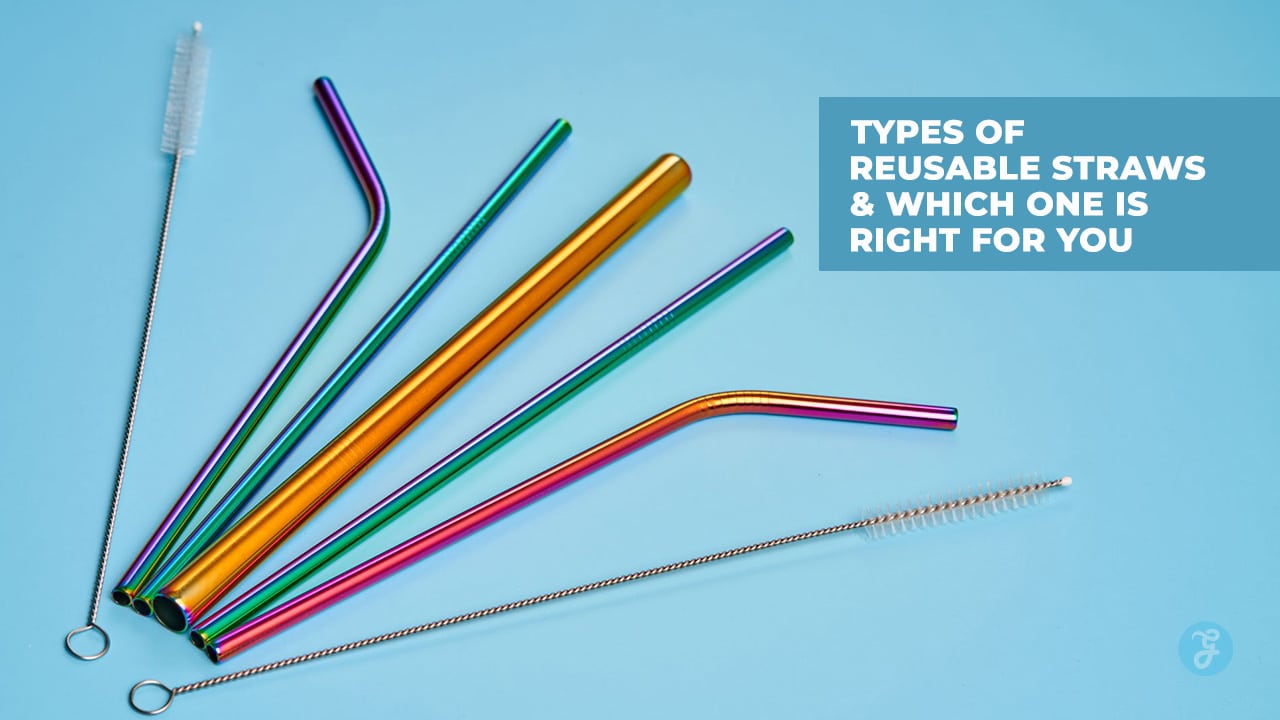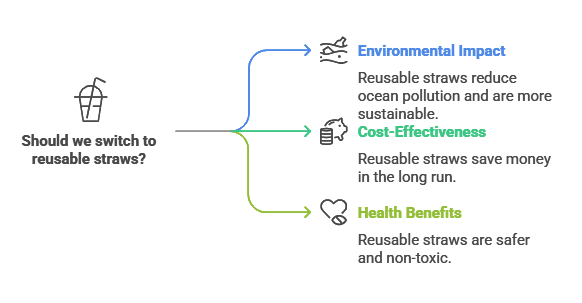Plastic straws have been a staple in beverage consumption for decades, but their environmental impact has become a major concern.
Millions of plastic straws end up in landfills and oceans, contributing to pollution and harming marine life. As a result, eco-conscious consumers are making the switch to types of reusable straws, which offer a sustainable and cost-effective alternative.
With a variety of materials available, choosing the right reusable straw can be overwhelming. Should you go for stainless steel, glass, bamboo, or silicone? Each type has unique features, benefits, and drawbacks.
This guide will break down the seven types of reusable straws, helping you select the best option for your lifestyle and needs.
Why Switch to Reusable Straws?
- Environmental Impact
- Plastic straws contribute significantly to ocean pollution.
- They take hundreds of years to decompose.
- Marine animals mistake plastic straws for food, causing harm or death.
- Many cities and countries are banning plastic straws, making reusable options more viable.
- Cost-Effectiveness
- A single reusable straw can replace hundreds of disposable plastic straws.
- Long-term savings compared to continuously buying disposable alternatives.
- Many reusable straws come with cleaning tools, making maintenance easier and cost-free.
- Health Benefits
- Many plastic straws contain BPA, which can be harmful to human health.
- Types of reusable straws are often made from non-toxic, food-grade materials.
- Safer for children and adults who want to avoid plastic chemicals.
- Prevents accidental ingestion of microplastics present in disposable straws.
7 Types of Reusable Straws and Their Benefits
Each type of reusable straw has unique features, making them suitable for different users and occasions.
1. Stainless Steel Straws
Stainless steel straws are one of the most popular choices for reusable straws due to their durability and sleek design. They are highly resistant to corrosion and do not leach chemicals into drinks.
Features & Benefits:
- Extremely durable and long-lasting.
- Resistant to rust and corrosion.
- Keeps drinks cold longer.
- Available in straight and bent designs for convenience.
Best For:
- Cold beverages like smoothies and iced coffee.
- People who prefer a sleek, modern look.
- Those who want a long-term reusable option.
Drawbacks:
- Can feel too hard on teeth.
- May alter the temperature of the drink.
- Not suitable for people with sensitive teeth.
| Feature | Stainless Steel Straw |
| Durability | High |
| Eco-Friendliness | High |
| Suitability | Cold drinks, travel |
| Cleaning | Requires brush |
2. Glass Straws
Glass straws offer a stylish and elegant drinking experience while allowing users to see through the straw to ensure cleanliness. Made from shatter-resistant borosilicate glass, they are safer than traditional glass options.
Features & Benefits:
- Transparent, making it easy to clean.
- Does not alter the taste of beverages.
- Aesthetic appeal for elegant drink presentations.
- Shatter-resistant options available.
Best For:
- Home use, where the risk of breakage is lower.
- Those who enjoy visually appealing drinkware.
- Eco-conscious consumers looking for a non-toxic option.
Drawbacks:
- Fragile and prone to breaking if dropped.
- Requires careful handling and storage.
- Can be expensive compared to other options.
| Feature | Glass Straw |
| Durability | Medium |
| Transparency | High |
| Suitability | Home use, elegance |
| Cleaning | Easy, dishwasher-safe |
3. Silicone Straws
Silicone straws are a favorite among families with children due to their softness and flexibility. They are bendable and ideal for hot and cold beverages.
Features & Benefits:
- Soft and flexible, making them safe for kids.
- Heat-resistant, ideal for hot and cold drinks.
- Available in various colors and styles.
- Does not conduct temperature like metal straws.
Best For:
- Kids and individuals with sensitive teeth.
- People who prefer bendable and comfortable straws.
- Hot beverage drinkers.
Drawbacks:
- Can absorb flavors over time.
- Requires thorough cleaning to prevent bacteria buildup.
- May not be as aesthetically pleasing as glass or metal options.
| Feature | Silicone Straw |
| Flexibility | High |
| Safety | Child-friendly |
| Suitability | Hot and cold drinks |
| Cleaning | Requires deep cleaning |
4. Bamboo Straws
Bamboo straws are an excellent biodegradable option, offering a rustic and organic aesthetic while being lightweight and reusable.
Features & Benefits:
- 100% biodegradable and eco-friendly.
- Lightweight and naturally antimicrobial.
- Unique, rustic aesthetic.
- Made from sustainable materials.
Best For:
- Eco-conscious consumers looking for sustainable alternatives.
- Tropical and organic-themed beverages.
- Those who prefer natural materials.
Drawbacks:
- Requires proper drying to prevent mold.
- Not as durable as metal or glass straws.
- Can absorb flavors over time.
| Feature | Bamboo Straw |
| Sustainability | High |
| Durability | Medium |
| Suitability | Eco-conscious users |
| Cleaning | Needs thorough drying |
5. Titanium Straws
Titanium straws are an ultra-premium choice for reusable straws, offering strength, lightweight properties, and resistance to corrosion. They are a great alternative to stainless steel due to their lighter weight and hypoallergenic nature.
Features & Benefits:
- Extremely lightweight yet highly durable.
- Non-corrosive and resistant to rust.
- Hypoallergenic and safe for all users.
- Does not react with acidic drinks.
Best For:
- Travelers who need a portable and sturdy straw.
- Those looking for a long-lasting, premium option.
- Individuals with metal sensitivities.
Drawbacks:
- More expensive than other reusable straws.
- May not be as widely available as stainless steel.
| Feature | Titanium Straw |
| Durability | Very High |
| Weight | Ultra-lightweight |
| Suitability | Travel, long-term use |
| Cleaning | Easy, dishwasher-safe |
6. Copper Straws
Copper straws add a stylish and elegant touch to any drink, making them a favorite for cocktail lovers. Their natural antimicrobial properties set them apart from other metal straws.
Features & Benefits:
- Aesthetic appeal with a vintage look.
- Natural antimicrobial properties reduce bacteria buildup.
- Enhances the flavor experience of some drinks.
- Ideal for special occasions and decorative drinkware.
Best For:
- Cocktail lovers and mixologists.
- Special occasions and parties.
- Those who appreciate a luxurious drinking experience.
Drawbacks:
- Requires regular polishing to maintain shine.
- Can react with acidic beverages like citrus juices.
| Feature | Copper Straw |
| Aesthetic | High |
| Durability | Medium |
| Suitability | Cocktails, special events |
| Cleaning | Requires polishing |
7. Recycled Plastic Straws
Recycled plastic straws are a more eco-friendly alternative to single-use plastic straws, offering a second life to repurposed materials.
Features & Benefits:
- Made from post-consumer recycled plastic.
- More durable than disposable plastic straws.
- Affordable and widely available.
- Lightweight and convenient for on-the-go use.
Best For:
- Budget-conscious consumers.
- Those who need an easily accessible reusable straw.
- Individuals transitioning from single-use plastic.
Drawbacks:
- Less durable than metal or glass options.
- Not biodegradable like bamboo straws.
| Feature | Recycled Plastic Straw |
| Sustainability | Medium |
| Durability | Low-Medium |
| Suitability | Everyday use |
| Cleaning | Easy, dishwasher-safe |
Takeaways
Switching to types of reusable straws is a small yet impactful step toward reducing plastic waste. Whether you prefer the durability of stainless steel, the elegance of glass, or the sustainability of bamboo, there’s a perfect reusable straw for everyone.
By making an informed choice, you can enjoy your favorite beverages guilt-free while contributing to a greener planet. Have you tried any of these reusable straws? Let us know your experience in the comments below!











































